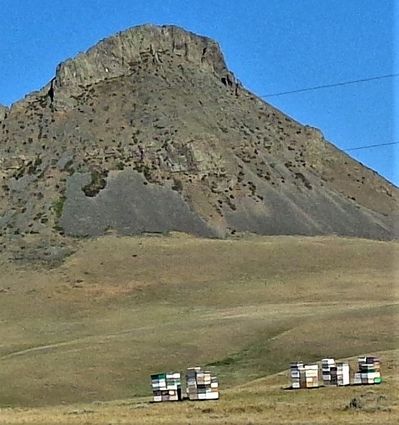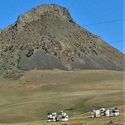South of the Border In the Sweet Grass Hills:"Honey: there's still gold in the Hills"
September 18, 2019

Brian Dyer, co-owner and operator of Montana Honey based in Fort Benton, poses beside one of his honey production sites along the Teton River north of Fort Benton. Dyer, a third generation beekeeper, started working with his family business in California. In 1987 he moved to Montana and started his own honey operation. He's been bringing hives to sites in the Sweet Grass Hills for about 30 years.
Columnist's note: In early July I looked out a bedroom window and saw an empty flatbed truck go by our house pulling a trailer with a machine I recognized as one used for moving beehives. A few days later, along Whitlash Road, I saw a couple of groups of beehives that I was sure were not there earlier. I asked some local ranch families about the hives and they assured me I was not confused, the hives had just arrived.
I'd never wondered about beehives in the Sweet Grass Hills. I talked to some ranchers who own land where I saw the hives and they told me about Brian Dyer. He operates Montana Honey, based in Fort Benton. Dyer is a third generation beekeeper who started working in his family's California bee business in 1974, then moved to Fort Benton in 1987 and began his own honey operation.
I contacted Brian to learn a bit more about the honey business and, specifically, what might be unique about bringing hives to the Sweet Grass Hills. Here's some of what I learned after a visit with him.
A bit of the history of Montana Honey, Inc.
Brian Dyer grew up in the honey business and came to Montana after working a few years in his family's business. He noted, "I produced more honey in California but the cost of doing business was lower here in Montana." He earned a degree in animal science in California. Asked if he studied bees in the animal science program in college, he laughed and said, "I studied how to manage beef and pork operations and studied veterinary, nutrition and ag business topics. It was all about learning to manage ag operations and that's what I'm still doing."
Describing the kinds of activities his business does Dyer said, "We produce honey using our own hives and bees and provide pollination services." Each spring to produce honey he puts out hives in Chouteau, Liberty and Toole Counties. That honey, harvested during September, is sold by the barrel to "one of the largest commercial honey packers in the country." The buyer packages and distributes the honey.
Most of the pollination work he does is in almond groves in California and involves hauling the hives and bees about 1400 miles to the area where almonds are grown. Pollination of almonds is done from December to April each year. Dyer said, "I make a trip out to check on the hives in the almond groves about every two weeks." About the time the work in California is done the bees are brought back to Montana to begin honey production.
I wondered what sorts of criteria were used to decide where and when to place the hives for honey production. Dyer explained that his bee colonies in Montana rely heavily on alfalfa and yellow sweet clover to provide nectar and there are many different plants that are good "pollen producers." With the nectar and pollen the final ingredient needed to make honey is water...and busy bees.
Dyer prefaced his remarks about honey production by stating, "Everything depends on rain. A timely rain can make virtually any areas good for honey production." Areas that were highly productive one year (got adequate and timely rain) may not produce well another season with lack of rain.
When the bees start making honey also depends on weather, especially temperature. Optimum temperature is between 80-85 degrees. If it's too cool the plants don't secrete what the bees need, too hot and the bees won't fly. Even elevation can affect honey production with 5000 feet being about the maximum acceptable height for placing hives.
Producing honey in the Sweet Grass Hills
Dyer has about 20 sites where he puts hives each year in the Hills. "I've been bringing hives to a lot of these same locations for thirty years," he explained. Many of the sites in the Hills were first secured by a previous company that Dyer bought. He said, "I've kept most of the original sites but sometimes a rancher stops growing alfalfa and that means a site is no longer used."
At the start of the season he brings 128 hives to one "distribution point" adjacent to Whitlash Road just south of the Hill community. He explained, "We have to load the bees, haul them to the Hills and set the hives in the dark to keep the bees calm. We don't often have time to haul and take the hives to the various locations." The hives are unloaded and then moved to the additional sites as weather warms. The hives are brought to the Hills about July 1, a little later than other hive sites further south.

Beekeeper Brian Dyer brings beehives to about 20 sites in the Sweet Grass Hills each spring, then "pulls the honey" in September. Hives are brought to the Hills in early July, about two weeks later than lower elevations. These hives are just off Whitlash Road with Haystack Butte in the background.
Beekeepers compensate landowners for the use of their land with "yard rent." It's a formula whereby honey is given to the landowner for each site on their property. Asked if honey from the Sweet Grass Hills has any particularly special or unusual qualities, Dyer said, "Not that I can tell."
Challenges to beekeepers
An economic threat that beekeepers united to deal with was the dumping of foreign honey (selling honey in America at an artificially low cost) without paying any tariffs. Dyer said, "About 15-20 years ago the beekeepers took a case against China's dumping of honey to the World Trade Organization (WTO) and won. The tariffs that China now pays to sell honey in the U.S. supports our lawyers who monitor dumping."
It's been widely reported about the loss of hives and bees to environmental challenges. Dyer said beekeepers are trying to educate the public about activities that put bees at risk. Dyer said, "A positive outcome of diminishing colonies is higher income for beekeepers who provide pollination services." He told of a beekeeper in California who hauls bees all the way to Maine to pollinate blueberries.
As you look to the Sweet Grass Hills, remember, "There's still gold in them thar hills."










